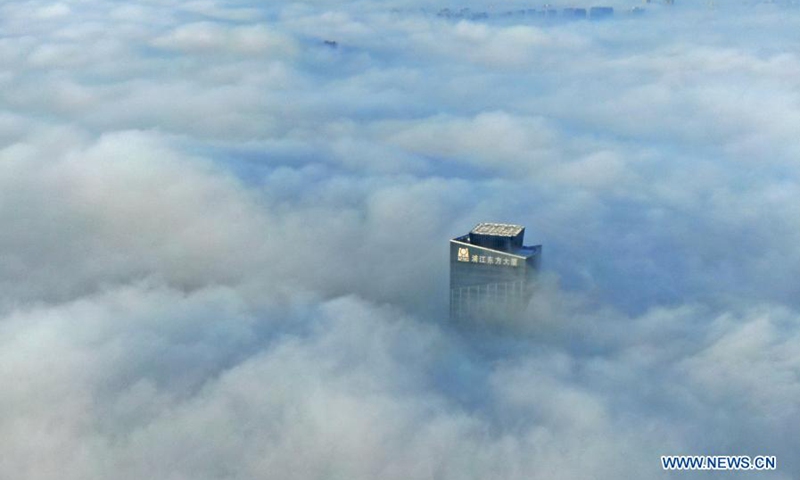China reaffirms ban on construction of skyscrapers taller than 500m for safety reasons

Aerial photo shows a skyscraper shrouded in fog in Hunnan District of Shenyang, northeast China's Liaoning Province on Jan. 26, 2021. (Xinhua/Yang Qing)
China has reaffirmed the ban on the construction of super high-rise buildings, prohibiting skyscrapers taller than 500 meters for pragmatic and security risk factors.
Skyscrapers taller than 150 meters are not allowed to be built in cities with less than 3 million people while buildings higher than 250 meters must not be constructed in cities with a larger population, the Ministry of Housing and Urban-Rural Development (MOHURD) and the Ministry of Emergency Management said in a statement on October 26.
According to the statistics of Council on Tall Buildings and Urban Habitat, a US nonprofit organization, China has 2,581 buildings taller than 150 meters, 861 skyscrapers higher than 200 meters and 99 super high-rise buildings above 300 meters. All three indicators remain number one in the world
China owns the largest number of super high-rise buildings in the world, said Huang Yan, deputy minister of Housing and Urban-Rural Development, at the annual meeting of Chinese city planning in late September.
As China builds extremely tall skyscrapers at the highest speed worldwide, problems have emerged in construction cost, energy consumption, security risks and environmental protection. They deviate from the new development philosophy and need to be tackled from the beginning of building constructions, said Huang.
China's super high-rise buildings resulted from highly concentrated population, severe lack of land and high land price in multiple cities, reported yicai.com, citing Ma Shaochun, associate professor of Henan University.
They are an important sign of economic prosperity and social progress, but have also triggered potential security risks in air traffic, fire and disaster prevention, as well as safety problems of the building itself, said Ma.
Earlier in May, Saige building, a 356-meter-high tower in downtown Shenzhen repeatedly shook due to multiple factors including strong wind, subway operations and rising temperature. It has suspended the operation for near four months, raising concerns about safety.
China' MOHURD and the National Development and Reform Commission (NDRC) jointly issued a document in April 2020 to further strengthen urban architecture management. The document said large buildings with strange styles for attracting public attention as a waste of resources, but still leaving possibility for the construction of buildings taller than 500 meters.
NDRC then announced a regulation in April this year on restricting the construction of skyscrapers over 500 meters and prohibiting the construction of "ugly buildings." It was not until the beginning of July that NDRC officially banned the construction of super high-rise buildings taller than 500 meters.
Global Times

Aerial photo shows a skyscraper shrouded in fog in Hunnan District of Shenyang, northeast China's Liaoning Province on Jan. 26, 2021. (Xinhua/Yang Qing)
China has reaffirmed the ban on the construction of super high-rise buildings, prohibiting skyscrapers taller than 500 meters for pragmatic and security risk factors.
Skyscrapers taller than 150 meters are not allowed to be built in cities with less than 3 million people while buildings higher than 250 meters must not be constructed in cities with a larger population, the Ministry of Housing and Urban-Rural Development (MOHURD) and the Ministry of Emergency Management said in a statement on October 26.
According to the statistics of Council on Tall Buildings and Urban Habitat, a US nonprofit organization, China has 2,581 buildings taller than 150 meters, 861 skyscrapers higher than 200 meters and 99 super high-rise buildings above 300 meters. All three indicators remain number one in the world
China owns the largest number of super high-rise buildings in the world, said Huang Yan, deputy minister of Housing and Urban-Rural Development, at the annual meeting of Chinese city planning in late September.
As China builds extremely tall skyscrapers at the highest speed worldwide, problems have emerged in construction cost, energy consumption, security risks and environmental protection. They deviate from the new development philosophy and need to be tackled from the beginning of building constructions, said Huang.
China's super high-rise buildings resulted from highly concentrated population, severe lack of land and high land price in multiple cities, reported yicai.com, citing Ma Shaochun, associate professor of Henan University.
They are an important sign of economic prosperity and social progress, but have also triggered potential security risks in air traffic, fire and disaster prevention, as well as safety problems of the building itself, said Ma.
Earlier in May, Saige building, a 356-meter-high tower in downtown Shenzhen repeatedly shook due to multiple factors including strong wind, subway operations and rising temperature. It has suspended the operation for near four months, raising concerns about safety.
China' MOHURD and the National Development and Reform Commission (NDRC) jointly issued a document in April 2020 to further strengthen urban architecture management. The document said large buildings with strange styles for attracting public attention as a waste of resources, but still leaving possibility for the construction of buildings taller than 500 meters.
NDRC then announced a regulation in April this year on restricting the construction of skyscrapers over 500 meters and prohibiting the construction of "ugly buildings." It was not until the beginning of July that NDRC officially banned the construction of super high-rise buildings taller than 500 meters.
Global Times

